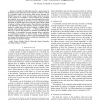Free Online Productivity Tools
i2Speak
i2Symbol
i2OCR
iTex2Img
iWeb2Print
iWeb2Shot
i2Type
iPdf2Split
iPdf2Merge
i2Bopomofo
i2Arabic
i2Style
i2Image
i2PDF
iLatex2Rtf
Sci2ools
129
click to vote
ROBOCOMM
2007
IEEE
2007
IEEE
Decentralized vehicle routing in a stochastic and dynamic environment with customer impatience
— Consider the following scenario: a spatio-temporal stochastic process generates service requests, localized at points in a bounded region on the plane; these service requests are fulfilled when one of a team of mobile agents visits the location of the request. For example, a service request may represent the detection of an event in a sensor network application, which needs to be investigated on site. Once a service request has been generated, it remains active for an amount of time which is itself a random variable, and then expires. The problem we investigate is the following: what is the minimum number of mobile agents needed to ensure that each service request is fulfilled before expiring, with probability at least 1 − ε? What strategy should they use to ensure this objective is attained? Formulating the probability of successfully servicing requests before expiration as a performance metric, we derive bounds on the minimum number of agents required to ensure a given perfo...
Communications | Mobile Agents | ROBOCOMM 2007 | Service Request | Spatio-temporal Stochastic Process |
| Added | 04 Jun 2010 |
| Updated | 04 Jun 2010 |
| Type | Conference |
| Year | 2007 |
| Where | ROBOCOMM |
| Authors | Marco Pavone, Nabhendra Bisnik, Emilio Frazzoli, Volkan Isler |
Comments (0)

